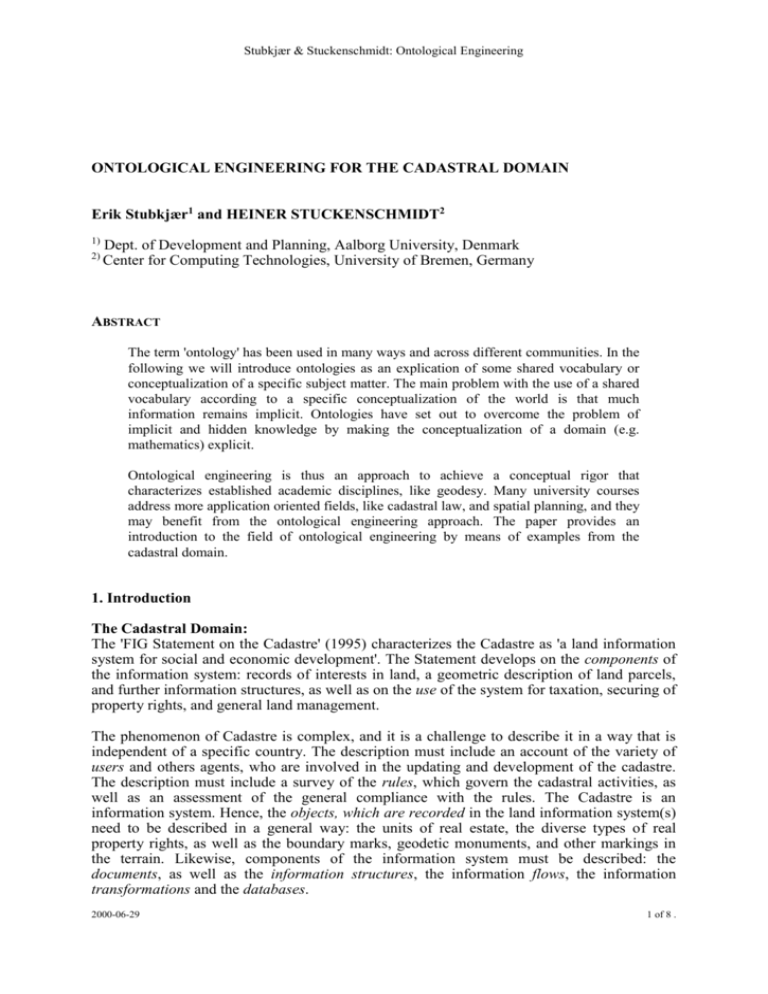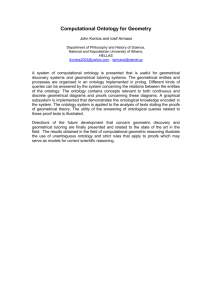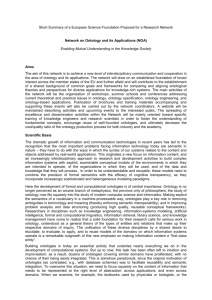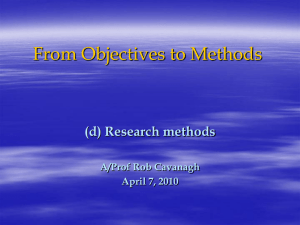Ontological Engineering for the Cadastral Domain
advertisement

Stubkjær & Stuckenschmidt: Ontological Engineering ONTOLOGICAL ENGINEERING FOR THE CADASTRAL DOMAIN Erik Stubkjær1 and HEINER STUCKENSCHMIDT2 1) 2) Dept. of Development and Planning, Aalborg University, Denmark Center for Computing Technologies, University of Bremen, Germany ABSTRACT The term 'ontology' has been used in many ways and across different communities. In the following we will introduce ontologies as an explication of some shared vocabulary or conceptualization of a specific subject matter. The main problem with the use of a shared vocabulary according to a specific conceptualization of the world is that much information remains implicit. Ontologies have set out to overcome the problem of implicit and hidden knowledge by making the conceptualization of a domain (e.g. mathematics) explicit. Ontological engineering is thus an approach to achieve a conceptual rigor that characterizes established academic disciplines, like geodesy. Many university courses address more application oriented fields, like cadastral law, and spatial planning, and they may benefit from the ontological engineering approach. The paper provides an introduction to the field of ontological engineering by means of examples from the cadastral domain. 1. Introduction The Cadastral Domain: The 'FIG Statement on the Cadastre' (1995) characterizes the Cadastre as 'a land information system for social and economic development'. The Statement develops on the components of the information system: records of interests in land, a geometric description of land parcels, and further information structures, as well as on the use of the system for taxation, securing of property rights, and general land management. The phenomenon of Cadastre is complex, and it is a challenge to describe it in a way that is independent of a specific country. The description must include an account of the variety of users and others agents, who are involved in the updating and development of the cadastre. The description must include a survey of the rules, which govern the cadastral activities, as well as an assessment of the general compliance with the rules. The Cadastre is an information system. Hence, the objects, which are recorded in the land information system(s) need to be described in a general way: the units of real estate, the diverse types of real property rights, as well as the boundary marks, geodetic monuments, and other markings in the terrain. Likewise, components of the information system must be described: the documents, as well as the information structures, the information flows, the information transformations and the databases. 2000-06-29 1 of 8 . Stubkjær & Stuckenschmidt: Ontological Engineering The cadastral domain includes the above elements and related issues, e.g. the economic and legal implications of a change of boundary location, and the historical and cultural context of the cadastre. Another term for this field of study is the cadastral universe of discourse. An initial theoretical account of the field is provided by Stubkjær (1996), and developed in Stubkjær (1999). Ontological Engineering: The present paper focuses on methods available for describing the cadastral universe of discourse in a way that supports learning and teaching, and research and development. Ontological engineering developed during the 1990s from artificial intelligence and computational linguistics. Both fields depend on knowledge representation and knowledge engineering. A frequently quoted definition of ontology is the one given by Gruber (1993): "An Ontology is an explicit specification of a conceptualization." Barry Smith has from the philosophers point of view characterized ontology in the present context as "a software artifact designed with a specific use and computational environment in mind" (1999). Therefore the first step of the ontological engineering process is the definition of the intended use of the ontology. In section 2 we define data modeling for the cadastral domain to be the intended use of the ontologies we want to build. There are established (and ever developing) methods for the analysis and design of information systems, and more specifically for establishing data models to map the content of databases (section 2a). Other descriptions of the content of databases exist in terms of catalogues of meta-data that describe the content, quality and accessibility of data (section 2b). However, most data modeling approaches fail to capture all aspects of the information that is represented by the data. Often hidden assumptions and silent agreements as well as dependencies between different kinds of data are missed. Beyond this, the integration of different data models is a difficult problem. Ontologies are developed to provide an interface between diverse domains or universes of discourse. For example, ontological engineering is applied for establishing standards in the field of Geographic Information, as appears from the announcement of the EuroConference on the Ontology and Epistemology for Spatial Data Standards (EuroConference, 1999). In section 3 we address the topic of building an ontology by using existing concepts of the Cyc ontology, which we explore from a cadastral point of view. The computational environment of knowledge engineering has developed from stand-alone computer programs and databases to ontologies shared through the Internet. We mention the new XML-standard of the World-Wide Web and the ontology language OIL as means for the implementation and use of ontologies (section 4). Concluding, ontological engineering is suggested as a means for description of the cadastral universe of discourse, which supplement other approaches, for example Soft Systems Methodology and the use of the Unified Modeling Language (section 5). 2. Define Purpose: Information Modeling The first step in ontological engineering is the definition of the purpose the ontology is built for. This step is necessary, because the purpose always influences the way certain concepts are modeled. In knowledge engineering this phenomenon is known as the "Interaction Problem" (Bylander & Chandrasekaran 1988). The purpose we will assume in this paper is information modeling. For this introduction to ontology engineering we focus on cadastre as a special purpose information system, and only occasionally touch upon legal, geographical and other aspects. In order to clarify this purpose, we will start with a discussion of well-known techniques for data modeling and related them to ontological engineering. 2000-06-29 2 of 8 . Stubkjær & Stuckenschmidt: Ontological Engineering Data modeling developed as a means to specify a new or changed information system. Data models provide a means of communication between the users, the system developers and management that describe the information system. Two examples of data modeling, modeling the content of databases, and meta-databases, respectively, serve as a reference for the presentation of ontological engineering. 2a. Modeling the Content of Data Bases Worboys demonstrates the use of the entity-relationship family of models for spatial information. A planar configuration of nodes, directed arcs and areas is described graphically as Fig. 1, and as a database scheme as follows: AREA(AREA-ID) NODE(NODE-ID) ARC(ARC-ID, BEGIN-NODE, END-NODE, LEFT-AREA, RIGHT-AREA) Fig. 1 E-R model of planar configurations of nodes, directed arcs and areas After: Worboys, 1997; Figure 2.19 Worboys describes how the extended entity-relationship model allows for specifying subclass/superclass and generalization/specialization. This facility is extended in ontology descriptions. Furthermore, while ER-models do refer to real world entities their emphasis is on specifying database schemes that can be implemented in current database software. Ontologies, on the other hand, mainly aim at describing real world objects, events and actors. 2b. Meta-databases Meta-databases are established in several European countries, together with the development of a pre-standard for meta-data (CEN/ENV 12657:1998). The meta-database is a catalog, which describes digital maps and other collections of geo-related data. For example, the Danish meta-database provides entries via data product type, area name, organization, coordinates in diverse geodetic reference systems and title of product (GeodataInfo). The individual entries give an overview of each dataset and where to get further information about the dataset. In fact the overview is quite comprehensive. The main entry includes abstract, purpose, usage, datatype, e.g vector-data with topology, as well as reference to documentation, to related datasets and to example datasets. Further meta-data description 2000-06-29 3 of 8 . Stubkjær & Stuckenschmidt: Ontological Engineering includes dataset quality, spatial reference system, and coverage in time and space, as well as identifiers of objects in a map dataset, e.g. the number of control points, and copyright, price and other accessibility information. In the present context, it is interesting to note that the conceptual schema of the meta-data prestandard is formally specified according to the conceptual language EXPRESS, cf. ENV ISO 10303-11:1994. This applies generally to the pre-standards that were developed by the effort of CEN/TC 287 Geographic Information during the late 1990s (CEN TC 287, 1998). While the various ontological engineering projects use a different conceptual language than EXPRESS for the specification of schemas, the objectives and techniques applied are basically the same. The meta-data description differs from the database models of the previous section in the way that the description refers to real world objects, rather than to data elements of a database. The meta-data catalogue does refer to data, which generally are stored in a database, but the catalogue does not refer to the data structure of the database, as an ER-model would do. Rather, the catalogue describes the data from a users' or manager's view. The meta-data description differs from ontologies mainly in the scope of its content: An ontology mostly would regard real world objects, events, etc. and not 'only' their representation in data structures. However, you may say that a meta-data description, based on a formal schema, is an ontology of datasets. 3 Ontology Modeling and Integration: Exploring the Cyc-Ontology Having specified the domain of interest, the second step of the ontological engineering process is concerned with the actual modeling of that domain. This step can be further subdivided in three activities (Uschold & King 1995): 1. Ontology Capture 2. Integration of Existing Ontologies 3. Ontology Coding In the first step, important concepts and relations of the domain of discourse are identified and drafted in order to get an overview of the domain and ensure completeness of the resulting model. A contribution to this step has already been done by (Stubkjær 1996). Especially for complex domains like the one we are concerned with, the step of integrating existing ontologies is essential in order to reduce the modeling effort. In the following, we concentrate on this point by exploring an existing ontology (cf. item 2 above) in order to identify concepts that could be part of an ontology of the cadastral domain. The coding step (cf. item 3) is addressed in the next section. The Cyc ontology is publicly available on the internet (Cycorp, 1997), provided you identify yourself and your purpose. The content is divided into 43 sections, of which the following 14 are an extract that is presented in the Cyc sequence that is, without ordering from a cadastral point of view: Fundamentals Top Level Types of Predicates Spatial Relations Mathematics 2000-06-29 "Doing" Transfer Of Possession Agents Organizations Actors Professions Geography Information Agreements 4 of 8 . Stubkjær & Stuckenschmidt: Ontological Engineering Within the Geography section the top-most entity is #$SpatialThing: #$SpatialThing The collection of all things that have a spatial extent or location relative to some other #$SpatialThing. Note well that to say that an entity is a member of this collection is to remain agnostic about two issues. First, a #$SpatialThing may be #$PartiallyTangible, like #$Texas-State or wholly #$Intangible, like the #$ArcticCircle or a line or a plane referenced in a geometric theorem. Second, although we do insist on location relative to another #$SpatialThing, a #$SpatialThing may or may not be located in the physically observable universe. It is far from clear that all #$SpatialThings are so located: eg, a trajectory through the phase space of some physical system. If the intent is to imply location in the empirically observable cosmos, the user should employ this collection's spec, #$SpatialThing-Localized. isa: #$ObjectType genls: #$Individual some subsets: #$RadiallySymmetricObject #$BilaterallySymmetricObject #$Surface-Generic #$Border #$GeometricThing #$PureSpace #$ClothingItem #$Surface-Abstract #$Surface-Physical #$Angle #$TwoDimensionalShape #$Line #$FrameOfReference #$ThreeDimensionalShape #$AbstractShape (plus 898 more public subsets, 11848 unpublished subsets) The ontology makes clear that spatial phenomena are not all related to land. It needs some investigation to find out that the relation to land more appropriately can be established by the subsets #$Place and #$GeographicalRegion, rather than by the reference to #$SpatialThingLocalized. Of the subsets mentioned, #$RadiallySymmetricObject applies for boundary marks and geodetic monuments. Other subsets applies to the cadastral domain as well: #$Border, #$FrameOfReference and #$GeometricThing, but are not commented here due to space restrictions. Cadastral processes cannot be made without taking the legal aspects into consideration. Only two examples of sets are provided here: #$TransferringPossession regards the series of events that transfer rights and objects, in the Cyc ontology subsumed under the term: possession. A subset is #$TransferringOwnership. An other example, #$objectOfPossessionTransfer differs from the previous examples, as it refers to a set of relations between a change in user rights and something existing. These relations are a means to establish connectivity within the ontology as alternatives to the isa- and genls-relations. #$TransferringPossession A collection of events. In an instance of #$TransferringPossession, the possession of a single object (i.e., the #$objectOfPossessionTransfer) is transferred from one #$Agent to another. Thus, a #$TransferringPossession event alters the rights of TWO different agents to use the object in question; one agent loses some #$UserRightsAttribute over it, while the other agent gains some #$UserRightsAttribute over it. Each #$TransferringPossession event is both a #$LosingUserRights event and a #$GainingUserRights event. Note: In #$Buying events, #$Bartering events, #$Renting events, TWO such #$TransferringPossessions occur, because there are TWO objects which transfer possession. For example, in buying a car, the right to use the buyer's money is transferred to the auto seller, while the ownership of the car is transferred to the buyer. Both of the #$TransferringPossession events (one for each object) are #$subEvents of the instance of #$Buying, #$Renting, etc. See #$ExchangeOfUserRights. isa: #$DefaultDisjointScriptType #$ScriptType #$TemporalObjectType genls: #$SocialOccurrence #$GainingUserRights #$LosingUserRights some subsets: #$MoneyTransfer #$BorrowingSomething #$TakingCustodyOfAnimal #$Stealing-Generic #$MoneyTransaction #$GivingSomething #$TransferringOwnership #$Paying #$ArrestingSomeone #$Trapping #$MonetaryExchangeOfUserRights #$GiftGiving #$Buying #$Renting #$SaleByCreditCard 2000-06-29 5 of 8 . Stubkjær & Stuckenschmidt: Ontological Engineering (plus 1 more public subset, 54 unpublished subsets) In the Cyc ontology, the entity Real Estate is described as follows: #$RealEstate A collection of tangible objects. Each element of #$RealEstate is either a parcel of land or a land-based property that can be bought, sold, or rented. This includes buildings and parts of buildings such as office suites or condominiums, as well as parcels of land. Some prominent examples: #$GuantanamoNavalBase, #$NewYorkHiltonAtBroadway, #$WorldTradeCenter. isa: #$ProductType #$ExistingObjectType genls: #$SolidTangibleProduct some subsets: #$Building #$GroundsOfOrganization #$RailroadStation-Physical #$ThreeStoryBuilding #$TwoStoryBuilding #$OneStoryBuilding #$ModernShelterConstruction #$ModernHumanResidence #$SingleResidenceUnit (plus 1 more public subset, 80 unpublished subsets) The conception here is that the set #$RealEstate is a subset of the set #$SolidTangibleProduct, cf. the genls line. This is consistent with the notion that a element (unit) of #$RealEstate belongs to the set #$ProductType, cf. the isa line. However, while this conception may satisfy a construction engineer or a settler, is does not comply with the compound conception of real estate that is needed in a cadastral context. Firstly, the notion lacks reference to #$Border and the relation #$bordersOn. This could be achieved by arranging #$RealEstate as a subset of #$GeographicalRegion. A subset of #$GeographicalRegion is #$GeopoliticalEntity. The latter is another term for jurisdiction and as one may conceive a real estate as a jurisdiction that is governed by a citizen, one arrives at the following generalisations: The set of real estates is contained within the set of jurisdictions (or #$GeopoliticalEntity) that again is contained within #$GeographicalRegion and further within #$Place and #$SpatialThing. In this way we have repaired the set relation (genls) of #$RealEstate. The isa-relation can be repaired as well: The Cyc-comment to #$GeographicalRegion (not rendered here) states that ".. Each element of #$GeographicalRegion is a #$PartiallyTangible that may be represented on a map of the Earth." ".. like #$Texas-State .." (in the note to #$SpatialThing"). An element of #$RealEstate is an element of #$GeographicalRegion and thus also member of the #$PartiallyTangible collection. This fits with the cadastral conception of real estate as consisting of tangible land (and buildings), but the boundary of which may not be tangible. From the above explorative investigation of the Cyc ontology it appears that the ontology provides assistance to the explication and regimentation of cadastral concepts, in the sense that 'building blocks' and relations among these blocks are offered and provides a basis for a 'dialogue'. The available ontologies cannot be used uncritically, and the potential of the software to assist in the provision of consistency among definitions and relations has not been tested. 2000-06-29 6 of 8 . Stubkjær & Stuckenschmidt: Ontological Engineering 4 Implementation and Use: XML, Logic and Interoperability Many ontology modeling languages have been developed during the past decade (Corcho & Gomez-Perez, 2000) that can be used to implement ontologies. However, not all of these languages are suited for real-life applications. Some languages are too expressive to support automatic reasoning and many rely on a specialized run-time environment. Recently, the world-wide web standardization committee W3C has recommended languages for data and meta-data modeling. We consider XML as a candidate language for data modeling on the world-wide web. Furthermore, we mention the language OIL (Ontology Interchange Language, 2000) that integrates XML with a logical model that makes automated inference possible. Stuckenschmidt and Wache (2000) propose the use of the OIL language in order to achieve semantic interoperability between heterogeneous information sources. We think that the ability to exchange information between different databases while preserving the intended meaning will gain importance in the future. 5. Conclusion The paper has introduced ontological engineering as a means to establish a description of the cadastral universe of discourse, a description that is independent of the diversities of national rules and practices. Selected cadastral concepts are related to a generally available ontology, and the outcome provides a basis for the suggestion of developing a cadastral ontology. The paper has pointed to recent technology, which could support in a cost-effective way an international co-operation within a potential cadastral ontology project. The approach does not make superfluous methodologies like Soft Systems Methodology (SSM), or the use of the Unified Modeling Language (UML). Rather it suggests a representation method that is compatible with other approaches. We think that the effort to develop an ontology for the cadastral domain pays off in clearer notions and a solid basis for cadastral development. Acknowledgement Cycorp Inc.'s copyright to the Cyc ontology is hereby gratefully acknowledged. References Bylander & Chandrasekaran, (1988) Generic tasks in knowledge-based reasoning: The right level of abstraction for knowledge acquisition. In B. Gaines and J. Boose, editors, Knowledge Acquisition for Knowledge Based Systems, volume 1, pages 65--77. Academic Press, London, 1988. CEN TC 287 (1998) Geographic Information - Fundamentals - Overview http://forum.afnor.fr/afnor/WORK/AFNOR/GPN2/Z13C/PUBLIC/DOC/13425.PDF CEN/ENV 12657:1998 Geographic Information - Data description - Metadata http://forum.afnor.fr/afnor/WORK/AFNOR/GPN2/Z13C/PUBLIC/WEB/ENGLISH/pren.htm Corcho, O and Gomez-Perez A. (2000) A Road Map on Ontology Specification Languages. Proceedings of the workshop on Applications of Ontologies and Problem-Solving Methods at ECAI 2000, Berlin. Cycorp (1997) Cycorp, Inc. (No post address information) http://www.cyc.com EuroConference (1999) http://www.geoinfo.tuwien.ac.at/events/Euresco2000/gdgis.htm GeodataInfo Infodatabase on Geodata - A Danish Metadata Catalogue of Spatial Data http://www.geodatainfo.dk/index2.htm Gruber, T. R. (1993) A Translation Approach to Portable Ontology Specifications, Knowledge Acquisition, 5, 199-220. Ontology Interchange Language (2000) http://www.ontoknowledge.org/oil 2000-06-29 7 of 8 . Stubkjær & Stuckenschmidt: Ontological Engineering Smith, Barry (1999) Ontology: Philosophical and Computational. Draft. September 28th. http://wings.buffalo.edu/philosophy/faculty/smith/articles/ontologies.htm Stubkjær, Erik (1996) A Theoretical Basis for Cadastral Development. In: ELIS' 94 European Land Information Systems. Proceedings, Third Seminar of the European Co-operation Network for Education and Research in Land Information Systems (EUROLIS), Sept. 1994. Delft; Delft University of Technology, 1996 Stubkjær, Erik (1999) Cadastral research - Issues and approaches Kart og Plan Vol 59, no 3, pp 267 -278. Stuckenshcmidt and Wache (2000) Context Modeling and Transformation for Semantic Interoperability. Proceedings of KRDB 2000. Uschold, M and King, M (1995) Towards a Methodology for Building Ontologies Proceedings of the Workshop on Basic Ontological Issues in Knowledge Sharing at IJCAI-95,Montreal. Worboys, Michael F (1997) GIS: A computing perspective. London. Taylor & Francis. 376 p. CO-ORDINATES Prof., Lic.Agro. Erik Stubkjær Dept. of Development and Planning, Aalborg University, Fibigerstræde 11, DK 9220 Aalborg East Denmark voice +45 9635 8350, fax +45 9815 6541, est@i4.auc.dk Dipl.-Inf. Heiner Stuckenschmidt Center for Computing Technologies, University of Bremen Universitaetsallee 21-23, 28359 Bremen Germany voice +49 421 218 4554, fax +49 421 218 7196, heiner@tzi.de 2000-06-29 8 of 8 .







